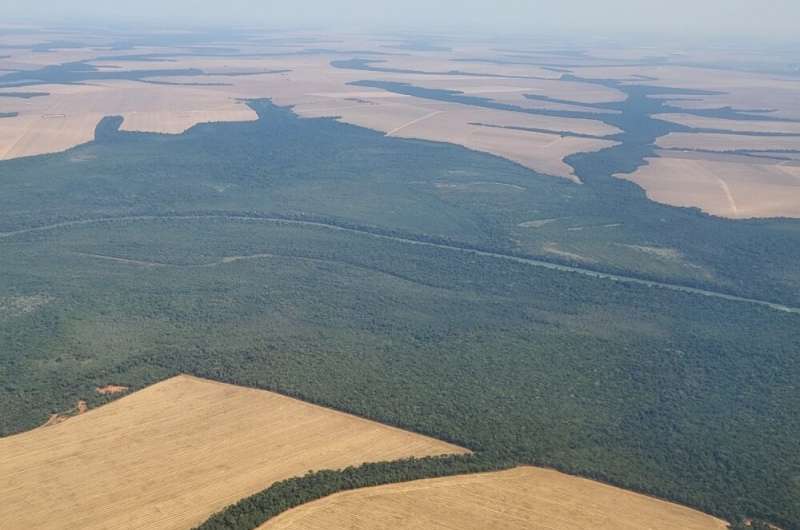This article has been reviewed according to Science X's editorial process and policies. Editors have highlighted the following attributes while ensuring the content's credibility:
fact-checked
peer-reviewed publication
trusted source
proofread
Number of fires in the Brazilian Amazon in August-September 2022 was highest since 2010

The number of active fires recorded in the Brazilian Amazon in August-September 2022 was the highest since 2010, according to an article published in the journal Nature Ecology & Evolution. Besides the record number of fires (74,398), the researchers found they were due not to extreme drought, as in 2010, but to recent deforestation by humans.
"The idea of publishing our findings came up when we analyzed data provided free of charge by the Queimadas program," said Guilherme Mataveli, first author of the article. 'Queimadas' in Portuguese means burnings, and he was referring to the forest fire monitoring service run by the National Space Research Institute (INPE). Mataveli is currently a postdoctoral researcher in INPE's Earth Observation and Geoinformatics Division.
The number of fires typically rises every year in August and September, when the weather favors fire in about half of the Amazon. "But the surge in the number of fires in 2010 was due to an extreme drought event that occurred in a large part of the region, whereas nothing similar occurred in 2022, so other factors must have been to blame," Mataveli said.
Mataveli's main research interest is the influence of land use and land cover on emissions of fine particulate matter from fire in the Amazon and Cerrado biomes using modeling and remote sensing.
The researchers also analyzed the locations of the fires detected using data provided free of charge by another INPE platform, TerraBrasilis. Their analysis showed that 62% occurred in recently deforested areas; that the number of fires in recently deforested areas in August-September 2022 rose 71% compared with the same period of 2021; and that the total deforested area increased by 64% according to the deforestation alerts issued by INPE's real-time detection system (DETER).
"Alarming results also emerged from our analysis of the type of land on which these fires occurred, classified into public land, smallholdings, and medium to large private properties," Mataveli said. More than a third (35%) of the fires detected in August-September 2022 occurred in public areas such as conservation units and Indigenous reservations, and the number of fires in these areas rose 69% year over year.
"The Amazon has become more vulnerable to grilagem [land grabbing via falsification of title deeds] in recent years, and this sharp increase is one of the results of this process," he said.
A key source of information for this land use and land cover analysis was TerraBrasilis, much of whose data comes from the Rural Environmental Register (CAR), designed to ensure compliance with the Forest Code. All landowners and land users are required to register with the CAR. The process is essentially self-declaratory, with the landowner entering environmental information about the property. Registration with the CAR is not required for conservation units, Indigenous reservations and other types of public land.
Climate goals
The advance of fire, deforestation, degradation, illegal mining and land grabbing in the Amazon runs counter to the goals established internationally by Brazil as part of its commitment to combat global warming, such as stopping all illegal deforestation by 2028 and achieving a 50% reduction in greenhouse gas emissions by 2030 compared to 2005 levels.
Besides the negative effect on biodiversity and maintenance of the ecosystem services essential to human life, such as climate regulation, the Brazilian economy is endangered by uncontrolled deforestation and associated activities. Markets for its exports of commodities, such as the European Union, are in the process of approving new regulatory standards that will prevent the purchase of goods produced in deforested or degraded areas.
"The article highlights a systemic problem that must be seriously addressed by society. A reversal of this trend requires punishment of those who break the law, implementation of efficient public policies, communication with society, and a search for alternative solutions based on cutting-edge science and capable of promoting sustainable development in the region. Identifying and prosecuting the people who are illicitly destroying the world's largest tropical forest is one of the challenging tasks on the environmental agenda to be faced by the incoming federal government," said Luiz Aragão, last author of the article.
More information: Guilherme Mataveli et al, Record-breaking fires in the Brazilian Amazon associated with uncontrolled deforestation, Nature Ecology & Evolution (2022). DOI: 10.1038/s41559-022-01945-2
Journal information: Nature Ecology & Evolution
Provided by FAPESP





















